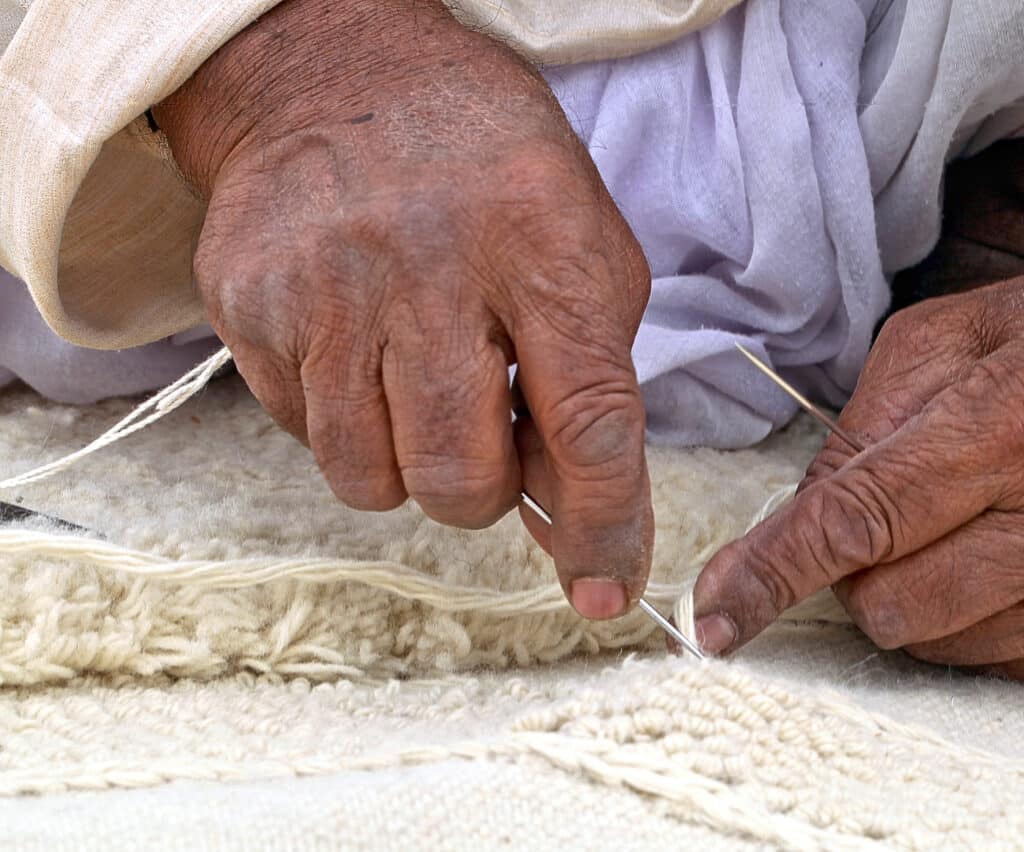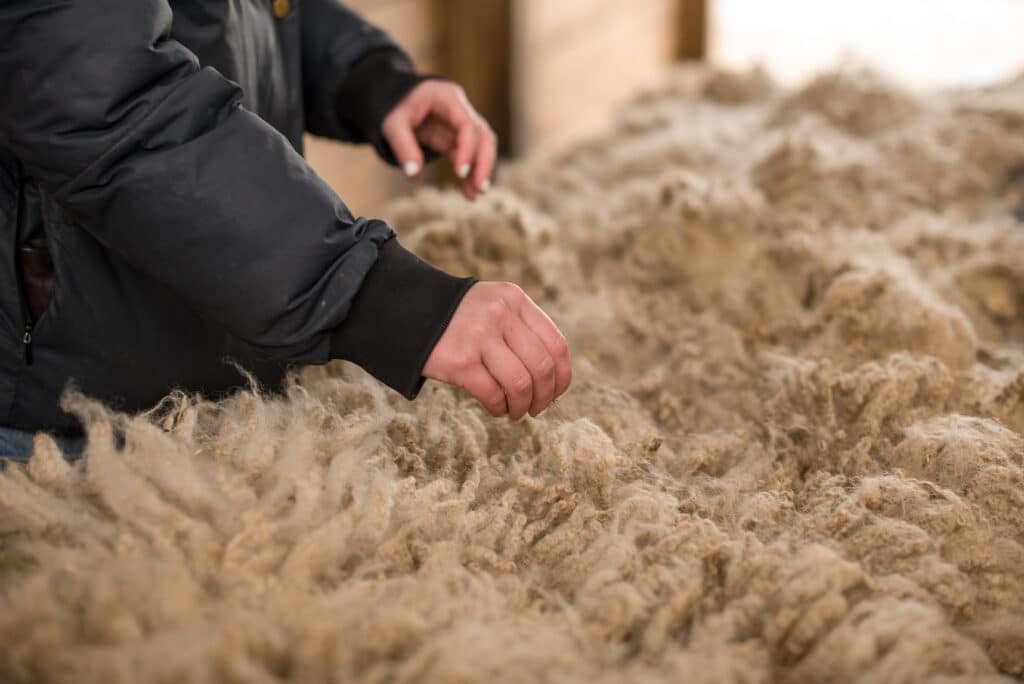Over the past fifty years, wool has lost favour in home interiors. The International Wool Textiles Organisation is working to try to remedy the misinformation around the product as a durable material. Denna Jones talks to Carol Sebert of Creative Matters Inc and new chair of the Interiors Working Group of IWTO about what can be done.

The job ahead is not for the fainthearted. Fortunately for wool, Carol Sebert is its champion. In 2022 Sebert, CEO and founder of Canadian rug company Creative Matters Inc, was chosen as the inaugural chair of the newly formed Interiors Working Group (IWG) of the International Wool Textiles Organisation (IWTO). Now in its 92nd year, the IWTO is a global body that ‘promotes a sustainable future for wool’. Its remit is ‘sheep to shop’ and ‘wool traceability’ that moves from four-legged provider to two-legged purchaser.
The challenge of promoting wool as the premier fibre option is the arching remit of the group. Sebert and colleagues have begun devising marketing and education strategies for trade professionals (interior designers, architects et al.) who specify flooring, and consumers who shop retail for rugs and carpets. Speaking to me from Kyoto where she was attending IWTO’s annual congress, Sebert explained how her group works closely with the Sustainable Practices working group as ‘we see that the two areas are closely aligned, and both require more education into the wonders of wool’. Were Sebert not diplomatic she would add that both groups have the challenge to defeat, or at least subdue, the wily ways of wool’s opposition: nylon and other fibre derivatives of Big Oil.

In February the IWG created a survey for the global wool community. Questions covered factors considered when wool products are bought for residential and commercial interiors. International respondents represented professions including interior designers, rug and carpet makers, rug retailers and wholesalers, architects, and sheep farmers. ‘It surprised me’ says Sebert, ‘that 40% of the respondents also made comments. We discovered the biggest concerns were shared across this diverse group.
‘Fossilised carbon is the root of the problem,’ she adds. This is true, but wool’s foe is like Hydra, the Greek mythological swamp-dweller with many heads. Two of the heads IWG must confront are incorrect or misleading wool ‘facts’ in media, and greenwashing from the synthetic fibre industry. A third head is the wool industry itself, where facts are sometimes knowingly or unknowingly distorted to support the use of synthetic fibres and latex. Sebert intends to ally fibre education to rug density. ‘The right quality in the right location,’ she states. Knots per square metre rather than knots per square inch (kpsi) can mask a low density, whereas industry standard kpsi is easier to visualise. Sebert adds that density of ‘pitch and row’ woven carpets is equally important.

An example of wool industry misdirection is provided by a European luxury wool carpet and rug company that defends the use of synthetic latex for its wool-tufted rugs. ‘A natural product may sound better than a synthetic one,’ its spokesperson told me in an email. He negatively compared the air miles of sourcing natural latex from Southeast Asia to synthetic latex ‘only 500 km away’. He added that ‘unlike small manufacturers, some of our products are used in public buildings, museums, airports, boutiques, embassies and must then also meet legal standards’—a defence tied to the problem with procurement standards discussed later in this article.
Sebert is keen to shift wool’s marketing from ‘sustainable’ to ‘regenerative’ to reinforce the idea of ‘sheep as part of the natural carbon cycle’. I posed the arguments of the luxury European rug company to Irish family-owned Ceadogán Rugs, which is committed to 100% regenerative, including its sheep and alpaca farm and its natural fibre-tufted rugs bound with rubber latex. Owners Colm Kenny and Martina Navrátilová refute the ‘legal standards’ excuse, and consider air miles a fallacious argument. ‘We’re small and we supply wool rugs to embassies and hotels! Our rugs are made without any of the adverse environmental or health effects associated with the use of synthetics.’
Synthetic fibre industries have had the jump on wool for more than fifty years. In the 1970s they convinced carpet manufacturers to add nylon to wool carpets for ‘durability’, a point made by Steve Parsons of Wools New Zealand in his comments for the survey. ‘Support should be behind flagship 100% wool products’ and ‘not [behind] 80/20 [wool/ nylon] as that [suggests] wool needs plastic to perform.’ Sebert agrees, but believes ‘we need the data’ to quash the myth. ‘We’ve got to go through the protocols, but proving 80/20 is not as good as 100% wool is low-hanging fruit.’

In his 2023 article ‘Construction Time Again’, technology reporter Patrick Sisson reveals that ‘all sorts of industry players are in the room when [building] codes are being made, including contractors, home builders and materials manufacturers.’ Similarly, synthetic fibre industries lobbied the US government to ensure their fibres were championed in procurement rules for public spaces—government offices, hospitals, schools. Petrochemical-based fibre rugs and carpets are thus the default option, and this thinking eventually infiltrated the commercial and domestic rug market.
Indoor air quality is a growing concern for human health. Better-quality materials in house builds is proven to result in fewer cases of negative respiratory and allergic issues, while better-quality rugs—meaning wool—actively improve indoor air quality by absorbing volatile organic compounds. The website of US-based Carpet & Rug Institute (CRI), whose board includes representatives from major US carpet manufacturers, states that ‘nylon, olefin (polypropylene), triexta, and wool are the primary fibers used in commercial carpet for healthcare applications’, a staggering ‘confession’ as healthcare is the last place one wants off-gassing carpet.

The CRI website also states ‘nylon accounts for approximately 80 percent of the overall commercial carpet market [in the US]’. Textile designer Kristie Strasen mentioned this in her IWG survey response. ‘Wool— in the US—is nearly impossible to find as a standard—even in higher end retail. The general public have been conditioned to believe that synthetics are superior. It is very unfortunate that the fibers [offered in retail] are olefin, polyester and even cotton—but NOT wool.’
Protocols that refute the 80/20 myth are a start, but Sebert’s group are up against an adroit and deep-pocketed opposition. The CRI’s ‘Green Label Plus’ programme ensures ‘stringent criteria for low chemical emissions’. Its certification is recognised by the U.S. Government’s Environmental Protection Agency in its ‘Recommendations for Specifications, Standards, and Ecolabels for Federal Purchasing’ that helps people to ‘identify and procure environmentally preferable products and services’. This example of Orwellian doublespeak is one of the ‘heads’ Sebert must try to slay.

Journalists who misunderstand or don’t carry out research into rug fibres is another vexatious issue. British Vogue ’s February 2023 article ‘Floor Fillers’ didn’t dismiss wool rugs, but neither did its writer regard wool as a sustainable and regenerative fibre. I tell Sebert the article champions ‘washable rug[s] made from recycled plastic because they’re a great use of waste materials’, and she quickly interjects: ‘They shed microplastics when they’re washed! And they unwittingly promote the continued use of throwaway water bottles and other plastic-based products that end up in our oceans!’ The journalist’s claim that PET rugs are ‘dead ringers for wool’ is a further point of exasperation for both of us, leading Sebert to describe how nylon may last, but unlike wool it ‘uglies out’.
When Hercules cut o one Hydra head, two grew in its place. He slew the monster by using fire to cauterise each neck wound. One of wool’s strengths is its lack of flammability. The Hydra might have survived if it had been smart enough to cloak itself in wool. Can Sebert outsmart wool’s own Hydra and become our industry’s Hercules? Don’t bet against her.




